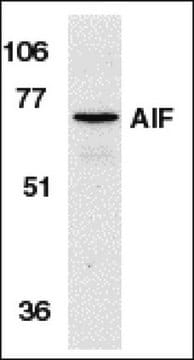MABC1190
Anti-Bin1 Antibody, clone 2F11
clone 2F11, from mouse
Sinonimo/i:
Myc box-dependent-interacting protein 1, Amphiphysin II, Amphiphysin-like protein, Box-dependent myc-interacting protein 1, Bridging integrator 1
About This Item
Prodotti consigliati
Origine biologica
mouse
Livello qualitativo
Forma dell’anticorpo
purified immunoglobulin
Tipo di anticorpo
primary antibodies
Clone
2F11, monoclonal
Reattività contro le specie
mouse, rat, chicken, human
Confezionamento
antibody small pack of 25 μg
tecniche
immunohistochemistry: suitable (paraffin)
western blot: suitable
Isotipo
IgG1κ
IgG1
N° accesso NCBI
N° accesso UniProt
Condizioni di spedizione
ambient
modifica post-traduzionali bersaglio
unmodified
Informazioni sul gene
chicken ... Bin1(424228)
human ... BIN1(274)
mouse ... Bin1(30948)
Descrizione generale
Specificità
Immunogeno
Applicazioni
Apoptosis & Cancer
Immunohistochemistry Analysis: A representative lot detected Bin1 in Immunohistochemistry applications (DuHadaway, J.B., et. al. (2003). J Cell Biochem. 88(3):635-42).
Western Blotting Analysis: A representative lot detected Bin1 in Western Blotting applications (DuHadaway, J.B., et. al. (2003). J Cell Biochem. 88(3):635-42; Muller, A.J., et. al. (2003). Mol Cell Biol. 23(12):4295-306; Chang, M.Y., et. al. (2007). Cancer Res. 67(1):100-7).
Immunohistochemistry Analysis: A representative lot detected Bin1 in Immunohistochemistry applications (DuHadaway, J.B., et. al. (2003). J Cell Biochem. 88(3):635-42).
Western Blotting Analysis: A representative lot detected Bin1 in Western Blotting applications (DuHadaway, J.B., et. al. (2003). J Cell Biochem. 88(3):635-42; Muller, A.J., et. al. (2003). Mol Cell Biol. 23(12):4295-306; Chang, M.Y., et. al. (2007). Cancer Res. 67(1):100-7).
Qualità
Immunohistochemistry Analysis: A 1:1,000 dilution of this antibody detected Bin1 in human cerebellum and human skeletal muscle tissue.
Descrizione del bersaglio
Stato fisico
Stoccaggio e stabilità
Altre note
Esclusione di responsabilità
Non trovi il prodotto giusto?
Prova il nostro Motore di ricerca dei prodotti.
Raccomandato
Codice della classe di stoccaggio
12 - Non Combustible Liquids
Classe di pericolosità dell'acqua (WGK)
WGK 1
Punto d’infiammabilità (°F)
Not applicable
Punto d’infiammabilità (°C)
Not applicable
Certificati d'analisi (COA)
Cerca il Certificati d'analisi (COA) digitando il numero di lotto/batch corrispondente. I numeri di lotto o di batch sono stampati sull'etichetta dei prodotti dopo la parola ‘Lotto’ o ‘Batch’.
Possiedi già questo prodotto?
I documenti relativi ai prodotti acquistati recentemente sono disponibili nell’Archivio dei documenti.
Il team dei nostri ricercatori vanta grande esperienza in tutte le aree della ricerca quali Life Science, scienza dei materiali, sintesi chimica, cromatografia, discipline analitiche, ecc..
Contatta l'Assistenza Tecnica.








